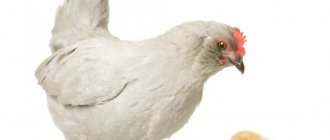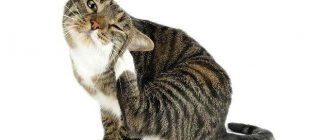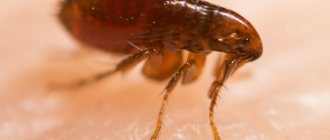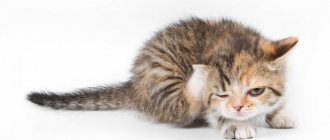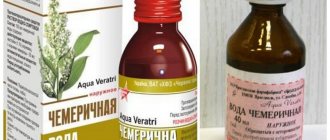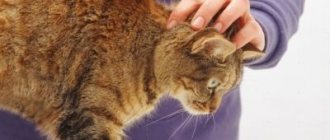Most cats avoid water treatments. However, this is one of the important components of hygiene. How correctly a kitten is bathed for the first time determines its attitude towards water for many years. Therefore, it is necessary to approach this event responsibly: choose a suitable detergent, study the advice of felinologists and, of course, be patient.
The advisability of bathing
Cats are very clean animals. They devote several hours every day to thorough licking. With the help of a rough tongue, pets are able to remove almost any dirt, as well as lost hair and skin flakes.
This desire for cleanliness has practical implications. Cats try to neutralize their own scent in order to sneak up on their prey unnoticed during the hunt.
Fear of water can also be explained. A wet pet quickly becomes hypothermic because it loses its ability to thermoregulate. Domestic cats living in “greenhouse” conditions have a rather weak immune system, which is not always able to withstand adverse factors.
If you bathe a kitten with an aggressive shampoo, the protective lubricant will disappear. Because of this, the fur becomes dry and brittle, and the skin begins to peel. Therefore, only special cosmetics are used for washing.
The kitten needs to be bathed when the following signs appear:
- the wool smells unpleasant;
- skin becomes sticky;
- abundant fatty deposits appear;
- the kitten has fleas;
- Dirt accumulates in the folds of the skin.
Cats are bathed if they are very dirty. For example, in any chemicals, soot, oil. In this case, licking the fur will cause serious harm to the health of the pet.
Indications
According to veterinary experts, there is no need to wash the animal unnecessarily. Bathing for most cats and kittens is extremely stressful, so this procedure should be resorted to only when necessary. However, there are reasons that can be considered objective indications for swimming.
The appearance of a kitten
If a kitten comes into the house, taken from a well-groomed domestic cat, then most often there is no need to bathe it.
Small pets adopted from a shelter usually do not require bathing. Employees of such organizations and volunteers, as a rule, give their charges to their new owners clean, neat and combed.
The situation is somewhat different when a kitten picked up on the street appears in the house.
In this case, the animal must be carefully examined, paying special attention to the condition of the ears, eyes, nose, abdomen and groin area.
You should inspect the fur no less carefully, running your fingers against it (you should first put on gloves). The presence of bald spots in the fur may indicate the development of lichen, and the presence of streaks and traces of pus in the area of the nose and eyes may indicate an infectious disease
After examining the pet, you need to carefully bathe it using a special antiparasitic shampoo.
If the cat gets dirty
Although cats and cats are considered clean animals, some of them do not live up to this stereotype at all. Some representatives of the cat family even manage to get dirty while in a clean house, without even leaving its confines.
Some cats' fur can quickly and frequently become dirty, matting into untidy tangles due to increased sebum production. This phenomenon is often observed in animals experiencing hormonal changes. In this case, pets also need to be bathed using a special zoo shampoo with an antiseborrheic effect.
Shedding
The period of intensive change of undercoat is one of the main reasons requiring more frequent bathing. During shedding, some of the dead hair remains and gets tangled in the fur, forming unsightly tangles and lumps. The animal is not able to cope with them on its own. Moreover, while trying to clean itself up, a shedding pet often choke on its own fur. Here it is also necessary to carry out a bath with further thorough combing of the dead undercoat.
Presence of parasites and fleas
The discovery of parasites and fleas in an animal's fur is a reason why a thorough bath should be carried out immediately
During the procedure, it is important to use a special zoo shampoo with an insecticidal effect. Such detergents help destroy parasites and prevent their further appearance.
In some cases, the procedure is repeated.
Preparation for the exhibition
Professional cat breeders know well how much effort it takes to prepare for exhibition events. Before the exhibition, purebred pets are washed using very expensive shampoos, which add shine and volume to the coat. Additionally, the wool is combed and styled with professional gels and varnishes.
The reasons listed above are the main reasons for giving your pet another bath. Veterinarians remind owners of cats and kittens who prefer to wash their animals too often that this can lead to the development of skin diseases, including massive hair loss.
Contraindications to bath procedures
There are situations when it is absolutely forbidden to bathe kittens. These include:
- Illness - avoid water procedures until complete recovery.
- Vaccination – bathing kittens is prohibited for 14 days after vaccination.
- Ringworm - along with water, the infection will spread to other parts of the body.
- Surgery – After surgery, cats are not bathed until the stitches have healed.
- Severe stress - water procedures will only aggravate the condition.
What to do next?
After bathing, the kitten is wrapped in a towel to absorb excess moisture. After a few minutes, the wet towel should be changed. There is no need to rub the little body, just blot it . Next, the wool is dried with a hairdryer, otherwise it will roll up and tangles will remain. In addition, a child who has not reached adulthood can catch a cold and get sick, because even in a warm room, the wool will dry completely only after 10–12 hours.
The scary buzzing device is kept at a distance of 30 cm from the cat. If it is possible to adjust the air supply, then it is better to choose a gentle mode.
At the end, the fur coat is combed out with a brush and the kitten is sure to be offered a favorite treat so that washing is associated with pleasant emotions.
At what age can you bathe a kitten?
Kittens are more vulnerable than adult animals. Their immunity is still developing, so you shouldn’t risk bathing your pet too early. During washing, the temperature regime is disrupted and the fatty film that protects the baby from pathogenic bacteria is washed off.
There is no need to bathe kittens for the first 2 months after birth. The mother takes care of their hygiene. However, many breeders wash kittens as early as 1 month. This is due to the fact that they prepare animals for sale and try to provide the kids with the most attractive appearance.
In case of severe contamination, you can carefully wash a one-month-old kitten, but only if it is accustomed to its owners and has become comfortable in the apartment. If possible, it is better to limit wiping with a damp cloth.
At 3 months, when the kitten is stronger, you can start bathing it without harm to its health. There is no need to postpone the procedure. The sooner the baby gets acquainted with water, the sooner he will get used to it.
As for at what age you can bathe a kitten with flea shampoo, it largely depends on its brand. Typically, such drugs are not used for up to two months.
However, some mild flea shampoos can be used a little earlier. It is better to consult a veterinarian first and carefully study the instructions.
ATTENTION, TEST! Answer a few simple questions and find out what kind of owner you are for your cat:
Does your cat have a name?
How often do you play with your pet?
Do you get your vaccinations and parasite treatment up to date?
Is your kitten spayed/neutered?
What do you feed your purr?
What kind of owner are you for your cat?
Your kitty is very happy
Congratulations! Your purr is healthy and happy, surrounded by care and love. You are a responsible and good owner for your kitty.
Your pussy could be happier
Hmm... with such an owner, even the cockroaches will all die. Maybe you should have gotten a cactus instead of a cat? Yes, you are not the best and most caring owner, but you still have a chance to fix everything. Start taking proper care of your pet.
There is no general consensus on how many times a pet should be bathed per year. When using shampoo, recommendations for the number of times it should be used will be indicated on the packaging.
How often to wash
Cats' natural love for cleanliness makes bathing an auxiliary, rather than a primary hygiene procedure. On the contrary, too frequent washing degrades the quality of the fur.
The frequency of washing kittens depends on the breed, coat length, and health status. As a rule, cats are bathed 6 times a year. If the animal does not leave the apartment, bath days are held once a quarter or six months.
Often you can only wash kittens of hairless breeds. They get dirty faster, so they get water treatments about once a month. Show cats are given unscheduled baths before shows.
For your information. If a cat goes outside, be sure to wash its paws after each walk.
Features of washing hairless cats
Cat litter: which options are best to choose
How to bathe a Sphynx kitten and how often should it be done? The fact is that hairless cats get dirty faster than their brothers in fur coats, so they will need bathing much more often. In addition, hairless breeds of cats sweat much more, and a lot of different debris can accumulate in their folds in the form of leftover food, litter, and lint.
It’s difficult to say for sure how many times a month to bathe a hairless pet. On average, this happens every 2-4 weeks, it all depends on its color and degree of contamination.
Bathing hairless cats has its own distinctive features
Typically, the following signs are a signal for water treatments in hairless cats:
- an unpleasant odor began to emanate from the pet;
- the baby's skin has become sticky and oily;
- Dirt is clearly visible in the folds of the skin.
But washing a bald baby too often will also not do him any good, since the special lubricant produced by the sebaceous glands is washed off, and the kitten is thus deprived of natural protection against various pathogens.
Important! Hairless cats are prone to rapid hypothermia after water treatments.
In general, the procedure for the first bath of an ordinary kitten and a small sphinx is not very different. The only difference is that you need to wash a hairless baby with a special soft sponge, carefully treating the fold areas, and use a special shampoo for cats without hair.
At the end of the water procedures, the kitten’s face, ears and back of the head are wiped with special sanitary napkins.
How to wash a kitten
Kittens are bathed using gentle products. Shampoos are not suitable for people - they are too aggressive.
Manufacturers produce cosmetics for a specific skin type:
- dry;
- fat;
- normal;
- damaged.
The most common are liquid shampoos and conditioners. They can contain both regular cleaning agents and special components. For example, to kill fleas, ticks and other parasites.
There are other types of cat shampoos:
- Dry shampoo is in powder form. Contains absorbent components: they remove excess sebum and dead skin flakes. However, it is not able to cope with heavy pollution. Used as an express remedy for show pets or kittens that are afraid of water. Suitable for use in winter as it avoids hypothermia.
- Spray shampoo - works almost the same as dry shampoo. Moisturizes and conditions the coat, helps get rid of tangles. A good option for partial bathing, when you just need to refresh your coat.
Some owners use a mixture of baby powder, cornstarch or baking soda as dry shampoo. However, this is quite risky. By absorbing moisture, starch releases gluten. If water gets on the skin, it will swell and stick to the fur.
It will most likely not be possible to comb it out - the animal will still have to be washed. The soda must be carefully removed, otherwise the cat will be poisoned by eating it while licking it.
Important. It is better to bathe animals using industrial dry shampoos. For example, brands Trixie Trocken and Mr. Gee.
When choosing a detergent, you need to take the following points into account:
- Short-haired, long-haired and hairless kittens are bathed with shampoos from separate lines.
- You should buy shampoos designed specifically for cats, or at least for cats and dogs. However, some show cosmetics are only made for dogs. It is used in extreme cases.
- Concentrated shampoos are more expensive, but are more economical. Before use, they must be diluted with water according to the instructions.
The most popular cosmetics that can be used to bathe a kitten are presented in the table.
| Effect | Name |
| Against parasites | “Disinfectant” (Bioflor company); |
| "Lugovoy" (Agrovetzaschita); | |
| “Tar” (Clandestine); | |
| "Doctor ZOO" | |
| Medicinal | "Doctor" (Goodman); |
| "BioVax for kittens"; | |
| Beaphar Shampoo Anti Dandruff | |
| For damaged skin and coat | Iv San Bernard Zeolithe |
| Strengthening and restructuring the coat | YuuP! Professional Restructuring & Strengthening; |
| Tropiclean Lime/Coconut | |
| To regulate shedding and against tangles | FURminator spray; |
| Perfect Coat Shed Control & Hairball (8 in 1); | |
| Phytoelite (Veda) | |
| Caregiver | Iv San Bernard Atami (antistatic); |
| “Gentle”, “Marine” (Agrovetzaschita); | |
| “Velvet” (CrystalLine); | |
| Artero 4Cats | |
| To add volume | Anju Beaute Texture Volume |
Important. The kitten may be hypersensitive to some component of the detergent. Therefore, after bathing you need to monitor the baby’s condition. If an allergy occurs, you should contact your veterinarian.
Selection of hygiene products
Never wash your kitten with human shampoo, even if it is a hypoallergenic baby shampoo. Also, detergents made for puppies, dogs, ferrets and other animals are not suitable for kittens. You should also avoid using shampoos for adult cats . In babies, the mucous membranes and skin are more susceptible; they may not withstand the effects of the components of the product for adult animals.
Thus, it is important to purchase a special product for washing your kitten.
The following varieties are suitable.
Universal liquid shampoo
A reliable, convenient product that foams well. For one session you will need a very small portion. The fur of a washed animal is shiny and soft and silky to the touch.
Dry shampoo
Suitable for pets who are terrified of water. Such products have nothing to do with the bathing procedure. Spray in the form of powder is applied to dry fur, which is immediately combed out. The faded hairs remain on the comb along with the dirt.
Recommended for animals older than 3 months.
Spray
Apply to the kitten's damp fur. The advantage is that it practically does not dry out the skin, which is important for kittens under six months of age.
Special shampoo
More often offered as options for a specific breed or for animals with a specific coat type, for example, for long-haired kittens, for British breed kittens, etc.
It is recommended to choose just such an individual product, since the composition of shampoo for Sphynx and Siberian cats will vary significantly and, if replaced, will not bring the desired effect.
Special shampoos for kittens are expensive. To save on product, take small bottles, since kittens grow quite quickly, and a small bottle will be enough for your pet’s entire childhood.
Don't pass by domestic products. In terms of quality, it is in many ways not inferior to goods from foreign manufacturers, and the price is much cheaper.
How to properly bathe a kitten for the first time
If you bathe a small kitten correctly for the first time, he will not develop negative associations with this procedure. Therefore, it is so important that washing is as comfortable as possible.
Felinologists recommend adhering to the following rules:
- Do not bathe your cat after eating. Only a light snack is acceptable, but it is better to wash your pet on an empty stomach.
- It is advisable that the kitten bathe during the molting period. Washing will make the process easier, and the animal will not accumulate a lot of hair in its stomach.
- Before bathing your pet, carefully comb the fur coat and untangle the tangles. To prevent the kitten from scratching, it is advisable to shorten the claws.
- The bathroom should be protected from drafts.
- To wash your kitten for the first time, it is better to use unscented shampoo.
- At first, it is better to bathe the kitten with an assistant. One person will hold the baby, the other will perform the necessary manipulations.
- The water should not be too cold or hot. Optimum temperature +38…+40°C.
- The ears are plugged with cotton to prevent water from getting into them. If this happens, inflammation may develop.
- It is better to wet your head not with a stream of water, but with a damp sponge.
It is recommended to wash the kitten for the first time not in the bath itself, but in a small basin. This will make it easier to hold him, and the pet will feel more confident. To prevent the paws from slipping, place a rubber mat on the bottom of the container.
For your information. It is not advisable to bathe a kitten in a sink. He can escape, fall from a great height and get injured.
All necessary equipment - detergent, towels, treats, etc. - should be at hand. If your pet scratches a lot, you should take care of rubber gloves. They will protect your hands from sharp claws.
When all preparations are completed, the kitten is gradually immersed in water approximately up to the shoulders. You can allow him to hold on to the edge of the basin and at the same time pour water on him. To bathe your pet without scaring it, talk to the baby in a gentle voice during the process. A friendly intonation makes it clear that there is no threat.
Shampoo is diluted in a separate container in the required concentration and applied to the kitten’s body. The soap solution is carefully distributed with massaging movements, being careful not to wet your head. Particular attention is paid to:
- armpits;
- stomach;
- areas around the genitals;
- paws;
- places behind the ears.
More dirt accumulates here. If your pet is bathed with an antiparasitic agent, the neck is treated first to prevent fleas from escaping to the head.
Leave the shampoo on the fur for the time specified in the instructions, and then rinse the kitten with plenty of water. It is better to water the baby from a mug or wet the fur with the palm of your hand than to use a tap or shower - a powerful stream will scare the pet.
At the end, the fluffy is generously praised and treated to his favorite treat to reinforce positive associations.
Inventory
Try to avoid bathing the kitten in the bath itself. A large space filled with water will cause stress and panic in the baby. To feel more protected, it is important for a pet to cling to something, but this is impossible to do in the bath.
Therefore, it is recommended to use a basin to wash the kitten.
A sink is also not suitable for these purposes. Firstly, this is dangerous for the kitten, because it will struggle and may fall from a great height, and secondly, it is inconvenient for the owners: splashes will fall on the walls and floor, the owner may slip, and then labor-intensive cleaning of the bathroom awaits him rooms.
To prevent the cat child from running away, it is recommended to attach it to a harness.
In addition, for stubborn kittens, you can purchase a special synthetic bathing bag.
It looks like a large mesh with a special cord that is fixed around the neck. This bag securely holds the pet and protects its owner from sharp claws and teeth. Water and shampoo penetrate well through the mesh cells. This attribute can also be used for other procedures that are unpleasant for the cat, for example, when trimming claws or cleaning ears.
During the bathing process, it is very important not to wet the kitten’s head and carefully avoid getting water into the ears. To do this, you can use cotton pads or purchase a swimming cap. You don’t need a washcloth to wash your animal; washing off dirt from a cat’s coat with your hands is easier, faster and better. In addition, the kitten may be frightened by a foreign object, but it is probably already accustomed to human hands.
How to wash representatives of different breeds
Representatives of different breeds require a special approach to bathing:
- Shorthaired Scots and Britons who devote a lot of time to grooming can be bathed once every six months.
- Long-haired cats, such as Persian or Siberian cats, need to be washed every 2 months.
- White kittens are bathed with whitening shampoos.
- Detergents for long-haired breeds are not used for short-haired kittens with abundant undercoat.
- It is not advisable to bathe kittens of white and blue colors, particolors and silver pets with herbal shampoos.
- To wash Sphynxes and other hairless cats, specialized shampoos are used that care for the skin. The head is wiped with sanitary napkins.
- Products for adding volume are not suitable for animals with tight-fitting hair without undercoat (Siamese, Oriental, Abyssinian cats, etc.).
How to teach a kitten to bathe
Bathing is a serious stress for your pet. To avoid health problems and not to injure the baby’s psyche, he needs to be prepared before the first wash.
Important. Kittens subtly sense people's moods. If the owner is nervous, the anxiety will be transmitted to the pet. Therefore, before swimming you need to calm down and relax.
First, the kitten is placed in a dry bath and they try to play with it. He needs to understand that it is safe here. When the baby gets comfortable, open the tap. Some pets themselves show interest and begin to play around with a thin stream of water.
The process is repeated several times until the kitten becomes absolutely calm about the procedure. Cats that cannot get used to water can be bathed in mesh bags. They restrict the movement of animals, but do not prevent water and detergents from entering the body.




